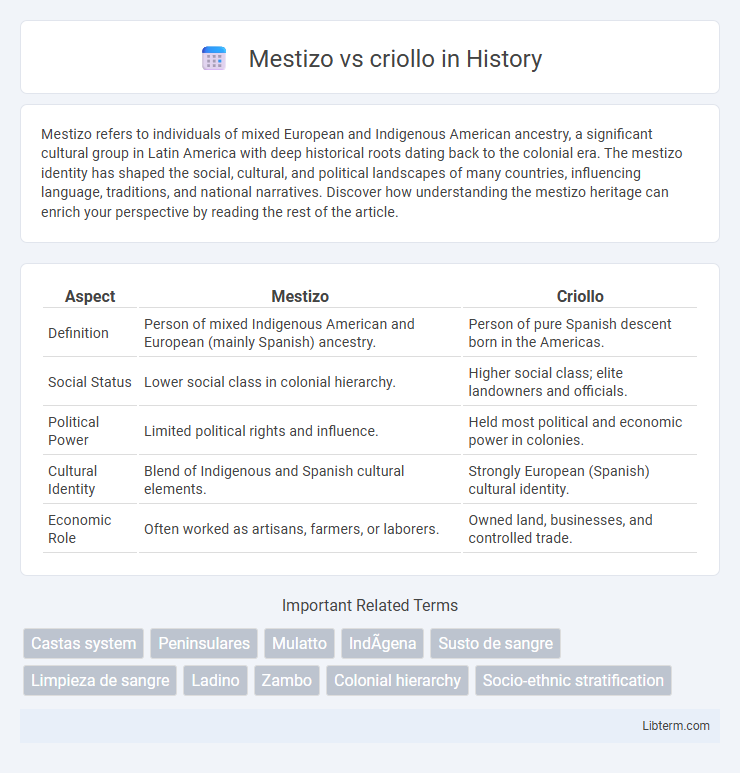Mestizo refers to individuals of mixed European and Indigenous American ancestry, a significant cultural group in Latin America with deep historical roots dating back to the colonial era. The mestizo identity has shaped the social, cultural, and political landscapes of many countries, influencing language, traditions, and national narratives. Discover how understanding the mestizo heritage can enrich your perspective by reading the rest of the article.
Table of Comparison
| Aspect | Mestizo | Criollo |
|---|---|---|
| Definition | Person of mixed Indigenous American and European (mainly Spanish) ancestry. | Person of pure Spanish descent born in the Americas. |
| Social Status | Lower social class in colonial hierarchy. | Higher social class; elite landowners and officials. |
| Political Power | Limited political rights and influence. | Held most political and economic power in colonies. |
| Cultural Identity | Blend of Indigenous and Spanish cultural elements. | Strongly European (Spanish) cultural identity. |
| Economic Role | Often worked as artisans, farmers, or laborers. | Owned land, businesses, and controlled trade. |
Introduction to Mestizo and Criollo
Mestizo refers to individuals of mixed Indigenous American and European, primarily Spanish, ancestry, representing a significant demographic in Latin America that reflects the cultural blending following colonization. Criollo denotes people of pure Spanish descent born in the Americas, historically distinguished from peninsulares born in Spain and often forming the colonial elite. These identities played crucial roles in shaping social hierarchies and cultural dynamics during the colonial era and beyond.
Historical Origins of Mestizo and Criollo
Mestizos originated from the unions between Indigenous peoples and Spanish colonizers during the early colonial period in Latin America, representing a mixed-race population that played a crucial role in the cultural and demographic landscape. Criollos were Spanish descendants born in the Americas, maintaining European ancestry while developing distinct colonial identities separate from Peninsulares, or Spain-born colonists. This differentiation marked social hierarchies, with Criollos often holding economic and political power, whereas Mestizos occupied diverse social roles shaped by their mixed heritage.
Social Hierarchies in Colonial Latin America
Mestizos and Criollos occupied distinct social tiers in Colonial Latin America, with Mestizos often positioned below Criollos despite shared Spanish ancestry. Criollos, born in the Americas to Spanish parents, held greater economic power and political influence, reinforcing their elite status over Mestizos, who were of mixed Indigenous and European descent. This hierarchy perpetuated systemic inequalities, limiting Mestizos' social mobility and access to privileges reserved for the Criollo class.
Key Differences Between Mestizo and Criollo
Mestizos are individuals of mixed Indigenous American and European ancestry, primarily Spanish, whereas Criollos are people of pure Spanish descent born in the Americas. Mestizos often occupied lower social and economic status in colonial Latin America, while Criollos held privileged positions in the colonial hierarchy and controlled land and political power. The cultural identity of Mestizos blends Indigenous and European elements, contrasting with the Criollos' strong European cultural ties and colonial elite status.
Cultural Influences and Identity
Mestizo identity blends Indigenous American and Spanish cultural influences, creating a hybrid heritage reflected in language, customs, and religious practices. Criollo culture emphasizes European Spanish descent and often aligns with colonial administrative and social structures, preserving Iberian traditions while adapting to New World realities. Both identities shape Latin American history by influencing social dynamics, cultural expressions, and concepts of belonging.
Economic Roles and Opportunities
Mestizos, often occupying artisan, laborer, and small-scale trader roles, had limited access to land and wealth compared to Criollos, who controlled large agricultural estates and lucrative mining enterprises. Criollos held dominant positions in colonial economies, leveraging inherited wealth and Spanish connections to maintain political power and economic privilege. The economic disparity reinforced social hierarchies, with Mestizos facing restricted opportunities for upward mobility within the colonial system.
Mestizo and Criollo in Contemporary Society
Mestizo and Criollo identities in contemporary society reflect complex cultural and social dynamics rooted in Latin America's colonial history. Mestizos, individuals of mixed Indigenous and European ancestry, often navigate a blended cultural heritage that influences identity politics, social status, and representation in modern urban and rural settings. Criollos, descendants of European settlers born in the Americas, maintain distinct cultural traditions and often hold different socio-economic positions, shaping debates on heritage, privilege, and national identity today.
Representation in Literature and Art
Mestizo and criollo identities play distinct roles in Latin American literature and art, where mestizos often symbolize cultural hybridity and indigenous-Spanish fusion, reflecting themes of identity and resistance. Criollo representation typically centers on colonial elite perspectives, emphasizing European heritage and social status, which influences classic literary narratives and colonial-era artworks. Modern reinterpretations challenge these portrayals, highlighting mestizo experiences as central to national identity and cultural expression.
Impact on Modern Latin American Politics
The distinctions between Mestizo and Criollo identities significantly shape modern Latin American political landscapes by influencing social hierarchies and representation within governments. Mestizos, representing a mixed Indigenous and European heritage, often advocate for inclusive policies that recognize multicultural identities and address historical inequalities. Criollos, descendants of European settlers born in the Americas, traditionally held elite political power but face evolving challenges as Mestizo populations gain increased political influence and push for reforms.
Conclusion: Legacy and Significance
The legacy of Mestizos and Criollos highlights the complex social stratification and cultural blending in Latin America, where Mestizos symbolize indigenous and European heritage fusion, while Criollos represent European descent born in the Americas. Both groups played crucial roles in shaping national identities, independence movements, and contemporary social dynamics. Their significance endures in ongoing debates about ethnicity, identity, and social hierarchy across the region.
Mestizo Infographic

 libterm.com
libterm.com